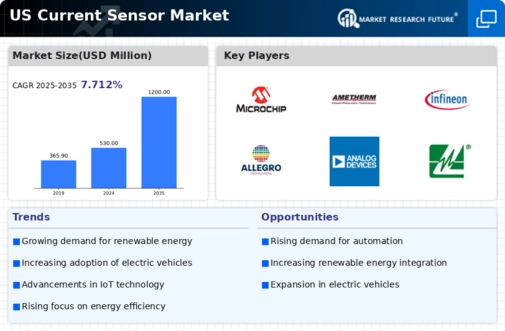Growth in Renewable Energy Sources
The current sensor market will benefit from the increasing integration of renewable energy sources into the US energy grid. As solar and wind energy installations proliferate, the need for effective monitoring and management of these energy sources becomes paramount. Current sensors are integral to ensuring the stability and efficiency of renewable energy systems by providing real-time data on energy flow. The US Department of Energy has reported that renewable energy accounted for approximately 20% of total electricity generation in 2025, a figure that is expected to rise. This shift towards renewables is likely to drive demand for current sensors, as they are essential for optimizing energy production and consumption. The current sensor market will grow alongside the renewable energy sector, reflecting a broader trend towards sustainable energy solutions.
Rising Demand for Energy Efficiency
The current sensor market is experiencing a notable surge in demand driven by the increasing emphasis on energy efficiency across various sectors. Industries are actively seeking solutions to monitor and manage energy consumption, which is leading to a heightened adoption of current sensors. According to recent data, the energy management systems market is projected to grow at a CAGR of approximately 15% from 2025 to 2030. This growth is likely to propel the current sensor market as these sensors play a crucial role in providing real-time data for energy optimization. Furthermore, regulatory frameworks in the US are increasingly mandating energy efficiency measures, further stimulating the current sensor market. As organizations strive to reduce operational costs and carbon footprints, the integration of current sensors into energy management systems appears to be a strategic move.
Technological Advancements in Automation
The current sensor market is experiencing growth due to technological advancements in automation across various industries. As manufacturing and industrial processes become increasingly automated, the need for precise monitoring of electrical currents is becoming more critical. Current sensors are essential components in automated systems, providing vital data for process control and optimization. The US manufacturing sector is projected to grow at a CAGR of around 4% from 2025 to 2030, which may lead to increased investments in automation technologies. This trend is likely to drive the demand for current sensors, as they enable manufacturers to enhance operational efficiency and reduce downtime. The current sensor market is thus expected to expand as industries embrace automation and seek reliable solutions for monitoring electrical parameters.
Increased Focus on Smart Home Technologies
The current sensor market is likely to see growth driven by the rising focus on smart home technologies in the US. As consumers increasingly adopt smart home devices, the demand for current sensors to monitor and manage energy usage is expected to rise. Current sensors play a crucial role in smart home systems by providing real-time data on electrical consumption, enabling homeowners to optimize energy efficiency. The smart home market is projected to grow at a CAGR of approximately 25% from 2025 to 2030, indicating a robust demand for current sensors. Additionally, the integration of current sensors into home automation systems enhances user experience by allowing for remote monitoring and control. The current sensor market will capitalize on the growing trend of smart home technologies, reflecting a shift towards more connected and efficient living environments.
Expansion of Electric Vehicle Infrastructure
The current sensor market is poised for growth due to the rapid expansion of electric vehicle (EV) infrastructure in the US. As the automotive industry shifts towards electrification, the demand for current sensors in EV charging stations is likely to increase significantly. Current sensors are essential for monitoring the flow of electricity during charging, ensuring safety and efficiency. The US government has set ambitious targets for EV adoption, aiming for 50% of new vehicle sales to be electric by 2030. This initiative is expected to drive investments in charging infrastructure, thereby enhancing the current sensor market. Additionally, the integration of smart charging solutions, which utilize current sensors for load management, is anticipated to further boost market growth. The current sensor market will benefit from the evolving landscape of transportation and energy.
























Leave a Comment